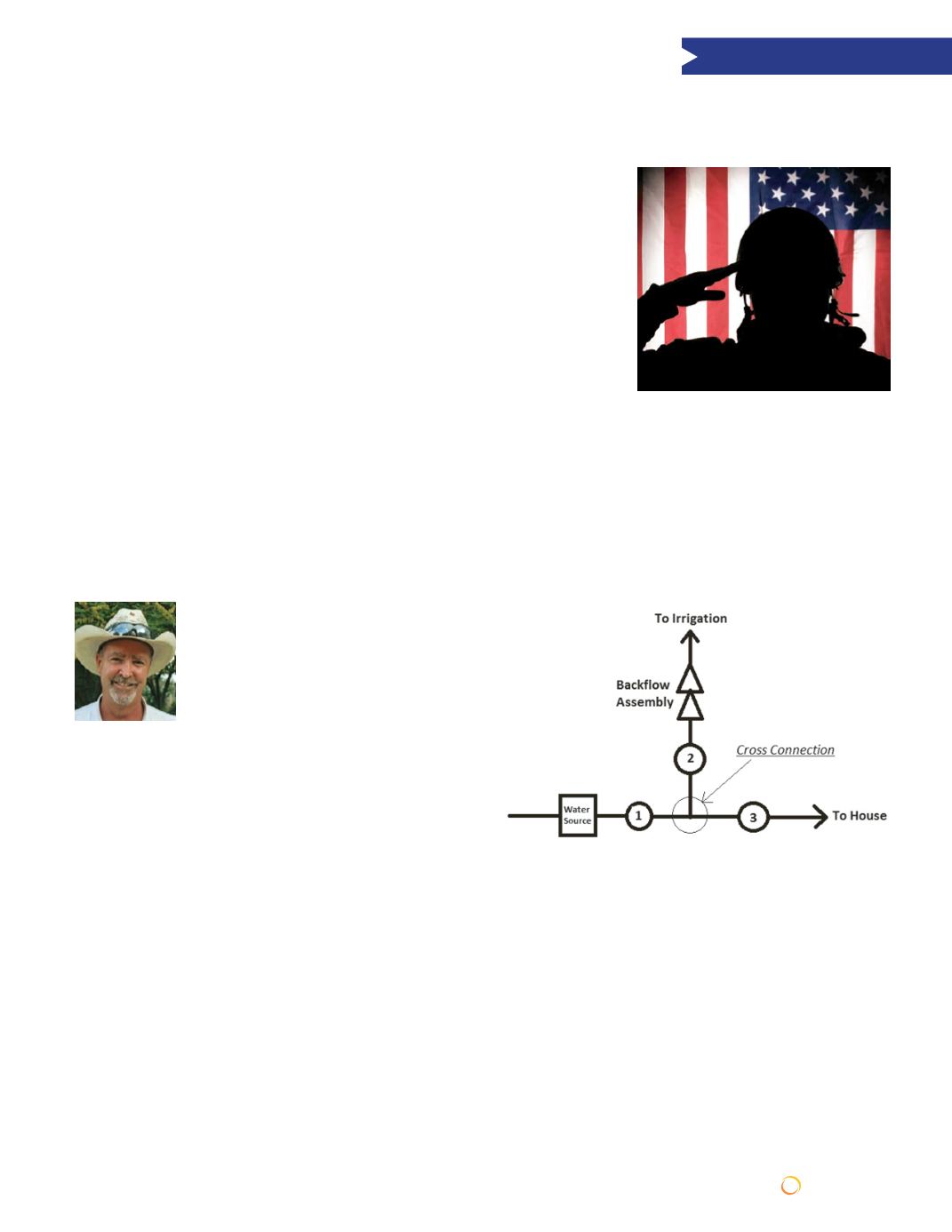
MAY 2015 SUNRAYS | 13
ONLINE:
SCTEXAS.ORG
W
hen an irrigation system is properly
designed and installed, it supplements
naturally occurring regional rainfall. In-
stallation begins with a cross connection
into the house supply line, downstream of
the water meter and emergency isolation
valve. Another isolation valve is installed
following the emergency valve, ensuring irrigation water is
kept separate from house water without supply interruption.
A third isolation valve allows homeowners to terminate water
supply to the house while on vacation.
Just beyond Valve 2, state law requires the installation of a
backflow assembly. Backflow is a reversal in the normal flow
of water within a potable water system. There are a number of
scenarios which can create backflow, and without a prevention
device, water can unexpectedly reverse and enter the drinking
supply. Of the various valve types available, the most commonly
used is the Double Check Valve Assembly.
Because it is difficult to irrigate an entire property all at once,
areas are divided into hydro-zones. These hydro-zones are or-
ganized by head types, plant material, turf, sun, shade and (in
some instances) soil quality. Once these zones are determined,
head placement and connection to the zone valves can begin.
State law stipulates that irrigation heads must be located in a
head-to-head formation, in which each head is required to throw
water at least as far as the next closest head. This ensures best
and most uniform possible coverage.
The brain of an irrigation system is the controller. The con-
troller determines when and for how long each hydro-zone is
CA NEWS
Are you a veteran of any branch of the
U.S. Armed Forces? Did you receive an
honorable discharge from active duty?
If you can answer yes to both of these
questions, then you and your spouse are
probably eligible for an incomparable
benefit provided by the State of Texas
– burial at a State of Texas Veterans
Cemetery. The Texas program allows
you to pre-register to reserve a space.
Internment is at no cost for the veteran
and minimal cost for the spouse. The
benefit includes: burial space, concrete
liner for casket, grave opening and clos-
ing, engraved headstone and perpetual
care. For cremated remains, you may
chose in-ground internment, Columbar-
iumWall internment, or distribution of
ashes in the Scattering Garden.
Veterans interested in this benefit should
review their eligibility with a veterans
cemetery representative, since misinfor-
mation continues to keep many eligible
veterans from applying. For further in-
formation and to arrange an appoint-
ment, you may call the Central Texas
State Veterans Cemetery in Killeen at
254-616-1770 or Sun City Texas resi-
dent J. Paul Comola, CTSVC Outreach
Volunteer, at 512-819-9953. Paul has all
the required forms and will assist you
with pre-registration. You will need a
copy of your DD214 and your marriage
certificate.
A visit to the Central Texas State Vet-
erans Cemetery before completing the
paperwork will allow you to see the high
caliber of the facility. The cemetery is
located about 13 miles north of Florence
on SH 195 (easily accessible from either
of the Sun City exits from Sun City Bou-
levard), and is open to the public daily
from 8 a.m. to 5 p.m.
Veteran burial benefits
Submitted by J. Paul Comola, Central Texas State Veterans Cemetery (CTSVC) Outreach Volunteer, 512-819-9953
Water Matters
Submitted by Carlton M. Mathis, Sun City Texas Water Management
allowed to run, based on the attributes of each zone. A simple
interface will allow users to program watering days and start
times and offer the capacity to operate all the installed electric
valves independently.
A range of rain shut off devices (required by state law) are
available, ranging from simple to complex. Basic models will
interrupt your programmed irrigation schedule when enough
measurable precipitation has been recorded, while more ad-
vanced devices make calculations based on recent to future
weather conditions. Only one is needed to complete the sys-
tem, but I have found that using a combination of rain, soil
moisture and freeze sensors to be the most effective for water
conservation.


